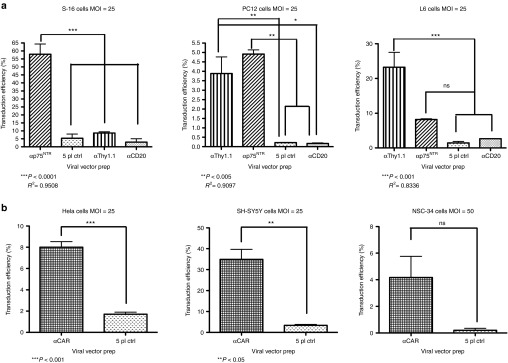Figure 2.

Selective and efficient transduction of rat, human, and mouse cell lines by αp75NTR, αThy1.1, and αCAR. (a) Rat Schwann cells S-16 (p75NTR-192 positive), muscle L6 (p75NTR-192 and Thy1.1 positive) and pheochromocytoma PC12 (p75NTR-192 and Thy1.1 positive) were spin infected with αp75NTR and αTh1.1 at an MOI of 25. 5pl and αCD20 vectors were included as non-targeted control vectors to assess the specificity of targeting. Seventy-two hours posttransduction, FACS analysis was conducted to analyze the percentage of EGFP-expressing cells. Mean values are presented in the graphs: S-16, 57.93 ± 11.16% for αp75NTR; PC-12, 3.8 ± 1.52% for αThy1.1, 4.91 ± 0.38% for αp75NTR; L6, 23.25 ± 8.55% for αThy1.1, 8.20 ± 0.43% for αp75NTR (mean ± SD, n = 3 experiments with different vector batches). (b) Human HeLa and SH-SY5Y cells and mouse NSC-34 cells were transduced with αCAR vector at MOI 25 and 50, respectively. 5pl vector was included as non-targeted control vector to assess the specificity of targeting. Seventy-two hours posttransduction, FACS analysis was conducted to analyze the percentage of EGFP-expressing cells. Mean values were: HeLa, 8.00 ± 0.52% for αCAR; SH-SY5Y, 34.91 ± 4.79% for αCAR; NSC-34, 4.16 ± 1.59% (±SD, n = 3 experiments with different vector batches). CAR, coxsackievirus and adenovirus receptor; CMV, cytomegalovirus; EGFP, enhanced GFP; FACS, fluorescence-activated cell sorting.
